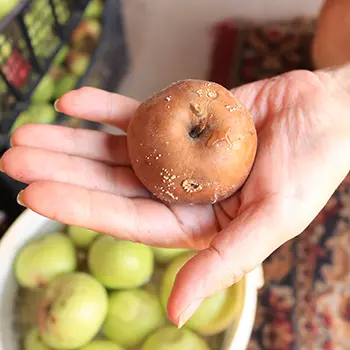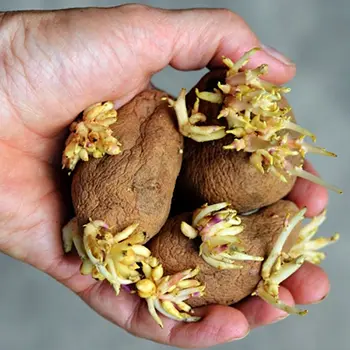Before the modern era of refrigeration, people had to find natural ways to keep fruits and vegetables from spoiling. Ancient peoples realized that they could build storage areas below the Earth’s surface which would be much cooler. Since these underground structures were commonly used to store root vegetables, they have come to be referred to as ‘root cellars’.
There is evidence of the use of root cellars as far back as 40,000 years, which means there are thousands of years worth of mistakes and lessons learned that we could all use to improve our root cellars.
Why Build A Root Cellar?
Modern refrigeration requires the use of electricity, which makes maintaining the temperatures needed to keep food from spoiling difficult, if not impossible, in a grid-down situation.
However, a properly designed and constructed root cellar will keep fruits, vegetables, and nuts from spoiling without the need for electricity.
While building a root cellar is a significant undertaking, it is a worthwhile investment if your goal is off-grid living or EMP preparedness.
There are, however, many mistakes that we must avoid at all costs when designing and building a root cellar.
Not Enough Ventilation
A root cellar must maintain temperature and humidity and enough ventilation to allow fresh air to come in and stale air to exit.
One of the reasons for the need to exchange air is the ethylene gas that some vegetables and fruits produce. Too much of this gas will cause other foods to spoil more rapidly.
Another reason that ventilation is needed is to maintain an appropriate humidity level.
Too little humidity will dry out the food, and too much moisture will cause mold, mildew, and rot. So install vents high up to remove the stale air and gas and vents closer to the ground to bring in the fresh air.
When installing ventilation, be sure to cover the opening with a screen to keep the critter out and purchase vents that allow you to regulate the airflow.
Keeping Fruits And Vegetables Too Close Together
I mentioned ethylene gas in the last section, which is a gas emitted by certain fruits and vegetables that can harm other fruits and vegetables. Therefore you must keep these foods separate.
Some foods that emit ethylene gas are apples, bananas, blueberries, cantaloupe, citrus fruit, grapes, green onions, honeydew, melons, mushrooms, nectarines, okra, papayas, passion fruit, peaches, pears, peppers, plantains, plums, quinces, tomatoes, watermelons.
Some foods that are negatively affected by ethylene gas are asparagus, broccoli, brussels sprouts, cabbage, carrots, cauliflower, cucumbers, eggplant, endive, and green beans. kale, kiwi fruit, leafy greens, lettuce, parsley, peas, peppers, potatoes, romaine lettuce, spinach, squash, sweet potatoes, watercress, and yams.
Neither of these lists is exhaustive, and before you start filling your root cellar, it is imperative that you thoroughly research the foods you plan on storing.
It is also essential that you plan to manage ethylene gas production inside your root cellar, arranging the shelves and storage areas with ethylene gas production in mind.
Not Being Dark Enough
Light is the nemesis of many foods you will want to store inside your root cellar. For example, exposure to light can cause potatoes to sprout and bleach out the color and nutrients of other fruits and vegetables.
If your root cellar has a window, you need to cover it to keep the light out.
Another option is to cover the fruits and vegetables with burlap to lessen the effect of any light that finds its way into the root cellar.
Not Monitoring Temperature And Humidity
There is no excuse for not having a robust method of dialing in and maintaining the temperature and humidity levels within your root cellar.
A wide range of devices will keep track of both temperature and humidity, and most of them are not very expensive.
Many devices will provide you with this information and track trends in the temperature and moisture over time. There are even devices that will send this data to your smartphone.
As you monitor the conditions inside your root cellar, you can make wiser decisions on regulating the ventilation to achieve the most consistent results.
The bottom line is that if you do not have something that will tell you what the temperature and humidity levels are, you can not effectively protect your supplies.
Using Concrete Floors
The problem with concrete floors is that they keep the moisture held in the dirt below them from entering the root cellar. Concrete also has a nasty habit of holding in heat, which we do not want for a root cellar.
If you are constructing a root cellar from scratch and choose what your floor will be made of, plain dirt is always the better option.
A dirt floor allows the moisture in the ground to enter the cellar and also aids in keeping the air cool.
If your root cellar already has a concrete floor, there is no need to break out the jackhammer.
As long as you are mindful of the conditions within the confines of the space, you can make the necessary adjustments to have a fully functional root cellar.
Going In And Out Too Often
Root cellars work best by keeping the cool, moist air inside where it is needed. It would be best if you kept the door of your root cellar closed as much as possible to maintain optimal conditions inside.
Every time you open the door, you allow heat to enter and cool air to escape. Not to mention that your body heat is also heating the air inside. To reduce the need to go into the root cellar, don’t store other items inside that you need regular access to.
Your root cellar is for food only, and the only reason you should be opening the door is to put more food inside or take some food out. When you need to take food out, plan ahead and take enough for a couple of days to avoid having to go inside daily.
A root cellar is an excellent backup to the modern refrigeration we all enjoy today. It is also a great way to store fruits, vegetables, nuts, and canned goods that you would regularly use.
Building a root cellar and using it regularly will give you the knowledge and skills to maintain your food security during a grid-down situation.
We must take the time to learn from the mistakes of others to construct and use a root cellar that will help guarantee our food security in the event of a widespread disaster or the loss of grid power.
You may also like:
How To Preserve Foods In Honey
An Insanely Effective Way to Build a 5 Year Food Stockpile (Video)
Foods You Should Never Buy And Always Make At Home










